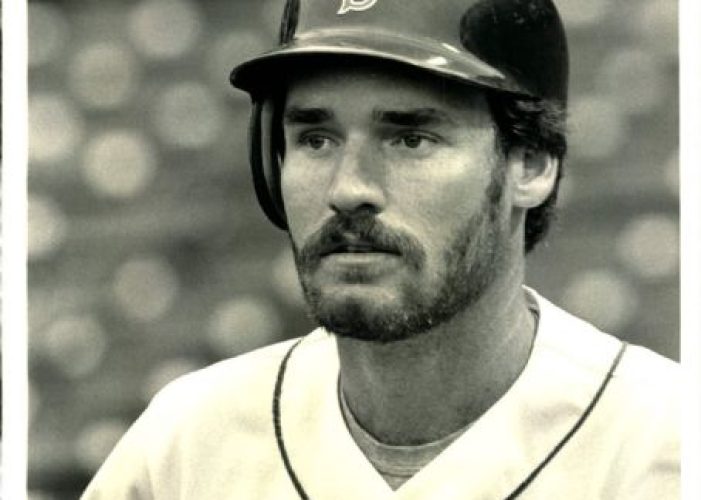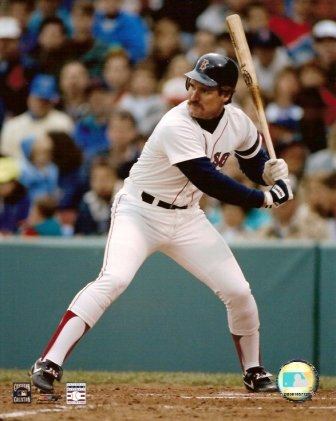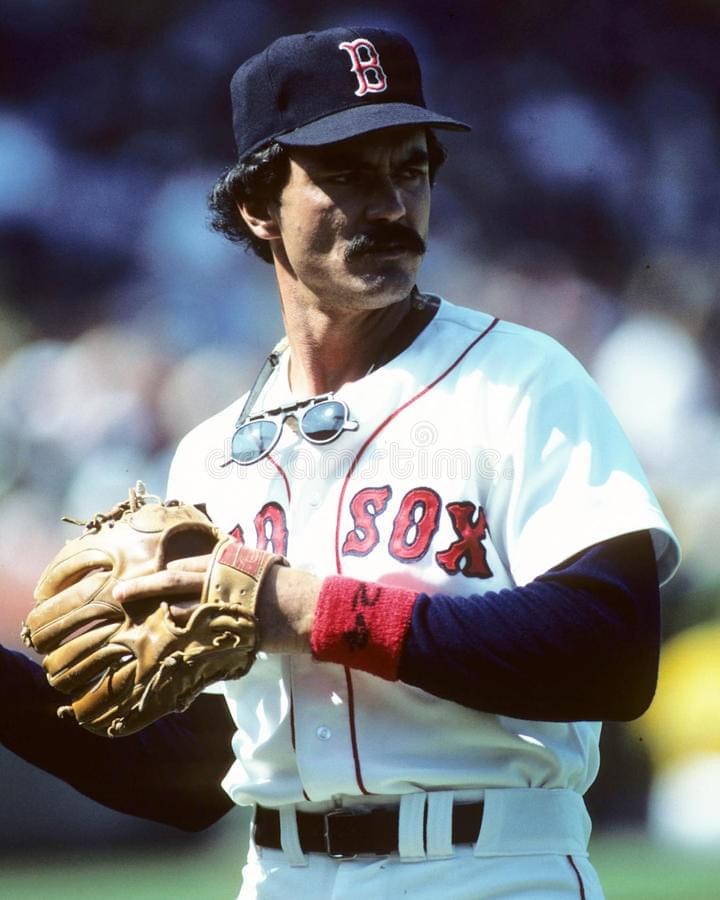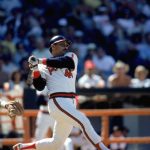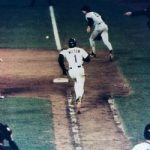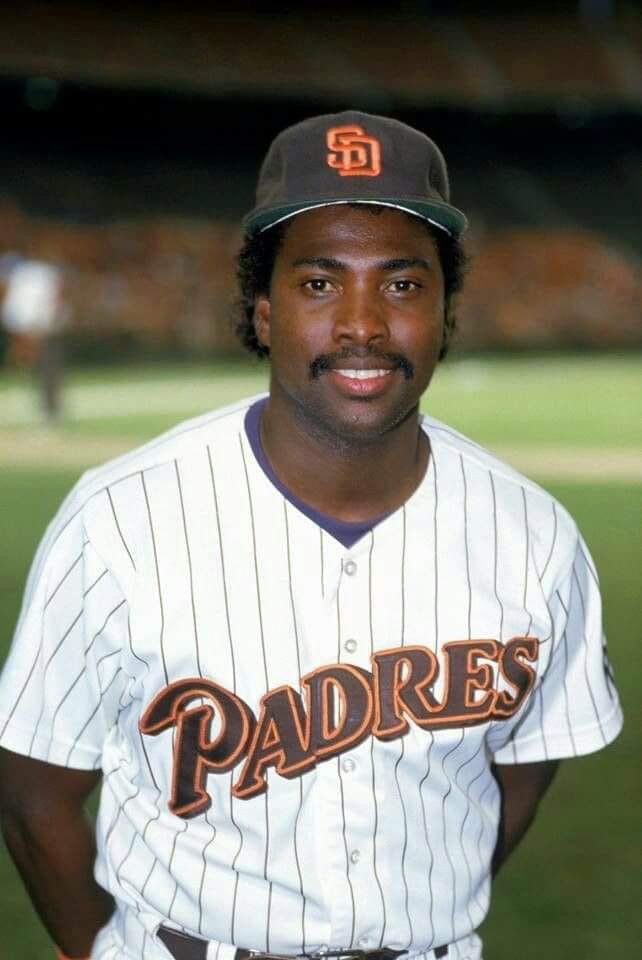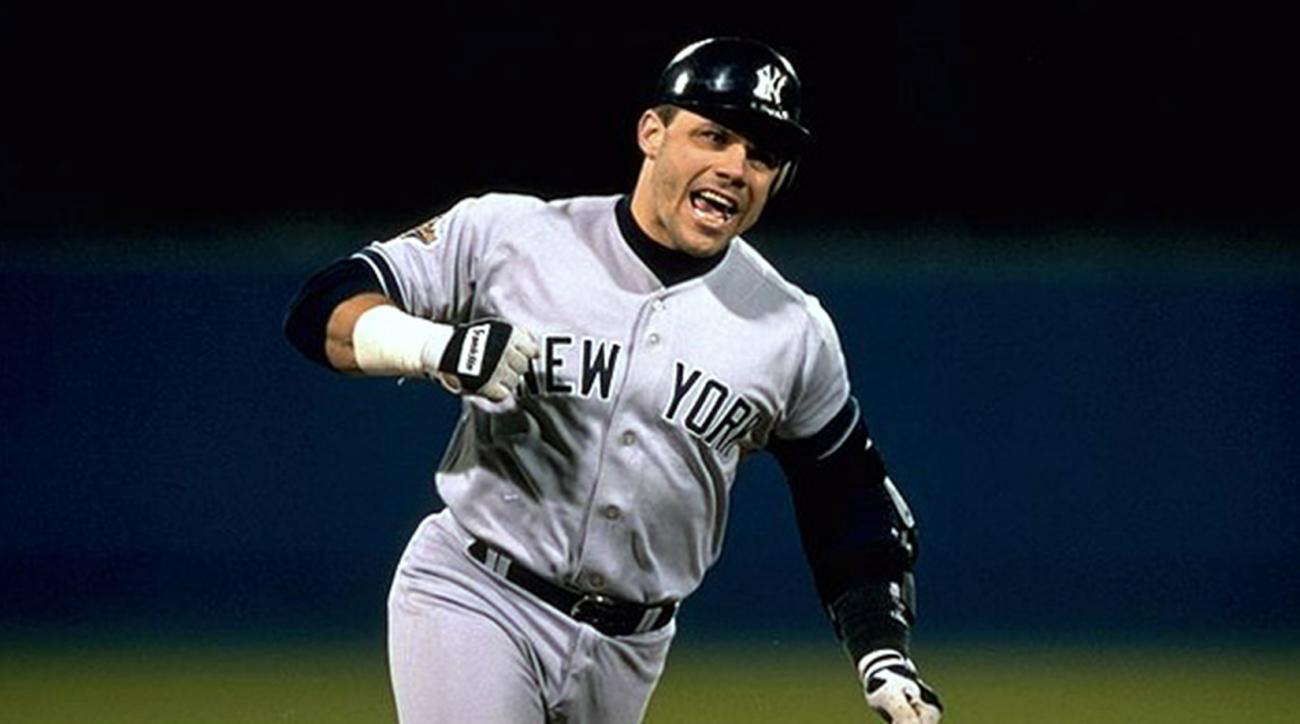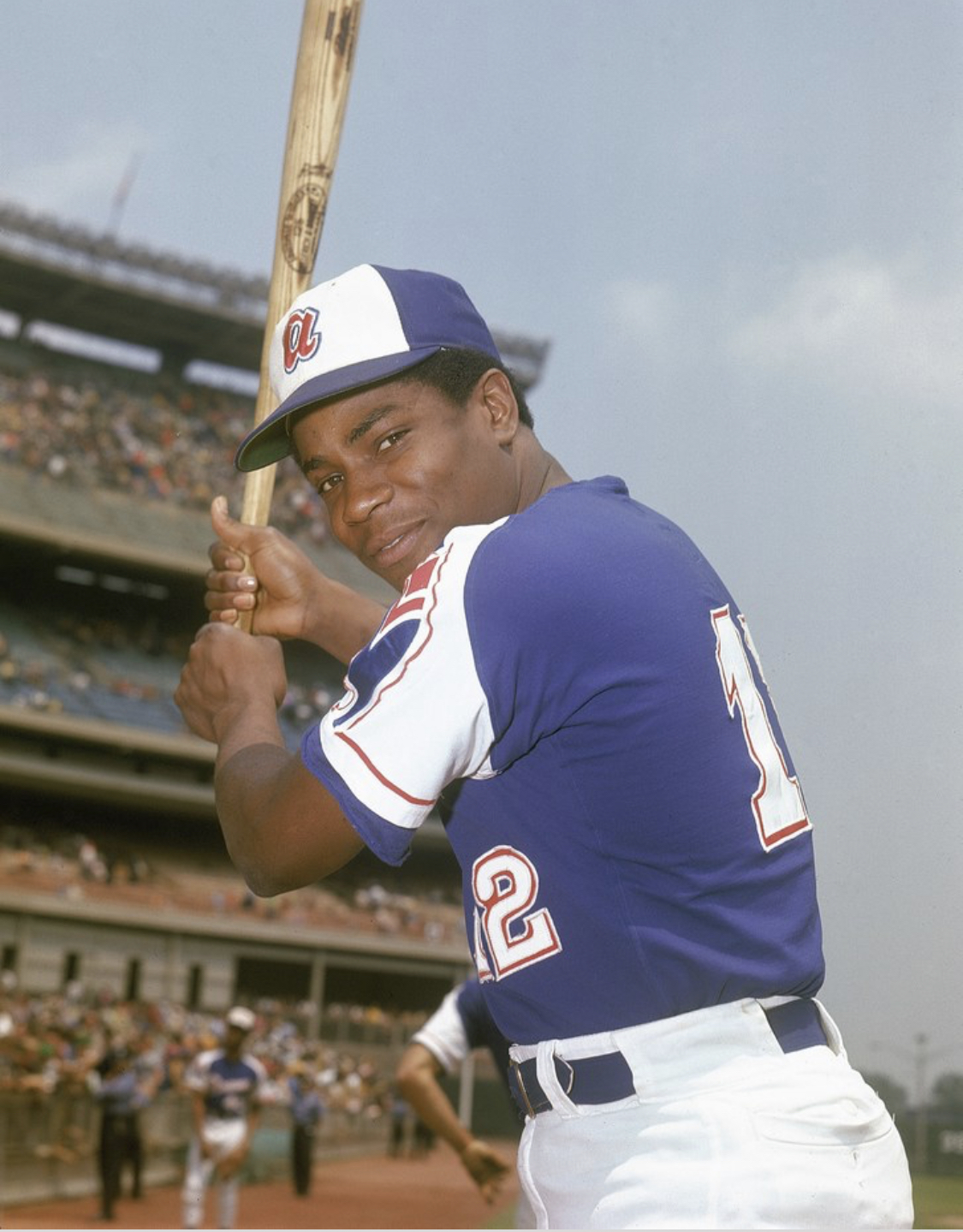Wade Boggs
Position: Third Baseman
Bats: Left • Throws: Right
6-2, 190lb (188cm, 86kg)
Born: June 15, 1958 in Omaha, NE us
Draft: Drafted by the Boston Red Sox in the 7th round of the 1976 MLB June Amateur Draft from H. B. Plant HS (Tampa, FL).
High School: H. B. Plant HS (Tampa, FL)
Debut: April 10, 1982 (14,583rd in major league history)
vs. BAL 4 AB, 0 H, 0 HR, 0 RBI, 0 SB
Last Game: August 27, 1999
vs. CLE 3 AB, 0 H, 0 HR, 0 RBI, 0 SB
Hall of Fame: Inducted as Player in 2005. (Voted by BBWAA on 474/516 ballots)
View Wade Boggs’s Page at the Baseball Hall of Fame (plaque, photos, videos).
Full Name: Wade Anthony Boggs
Nicknames: Chicken Man
Twitter: @ChickenMan3010
View Player Info from the B-R Bullpen
View Player Bio from the SABR BioProject
Nine Players Who Debuted in 1982
Tony Gwynn
Wade Boggs
Julio Franco
Willie McGee
Tony Phillips
Don Mattingly
Frank Viola
Doug Jones
Kevin Bass
The Wade Boggs Teammate Team
C: Rich Gedman
1B: Don Mattingly
2B: Marty Barrett
3B: Carney Lansford
SS: Derek Jeter
LF: Jim Rice
CF: Bernie Williams
RF: Dwight Evans
DH: Carl Yastrzemski
SP: Roger Clemens
SP: Bruce Hurst
SP: Oil Can Boyd
SP: Andy Pettitte
SP: David Cone
RP: Mariano Rivera
RP: Jeff Reardon
M: Joe Torre
Notable Events and Chronology for Wade Boggs Career
INTROBlessed with a keen batting eye, tremendous patience at the plate, great bat control, and an exceptional opposite-field stroke, Wade Boggs rivaled Tony Gwynn as the finest scientific hitter of his era. Boggs certainly was not a prototypical power-hitting third baseman, in the mold of a Mike Schmidt or an Eddie Mathews. He didn’t drive in runs at nearly the same rate as either Schmidt, Mathews, or George Brett. Nor did Boggs excel in the field the way extraordinary glove men such as Brooks Robinson and Graig Nettles did. However, Boggs hit for average and got on base better than any other third baseman in baseball history. His career batting average of .328 and lifetime on-base percentage of .415 are the highest marks posted by any player who ever manned the position, and his 3,010 hits, 1,513 runs scored, and 578 doubles place him second only to Brett on the all-time list among third basemen. A five-time American League batting champion, Boggs topped the junior circuit in batting four consecutive years at one point, compiling averages of .368, .357, .363, and .366 over that stretch of time. His extraordinary hitting ability enabled Boggs to surpass the .300-mark in batting in each of his first 10 seasons, and in 15 of the 18 years he took the field during his Hall of Fame career.
WADE BOGGS BIOGRAPHY
Born in Omaha, Nebraska on June 15, 1958, Wade Anthony Boggs spent six long years in the minor leagues before finally earning a roster spot on the Boston Red Sox at the start of the 1982 campaign. A 1976 graduate of Plant High School in Tampa, Florida, where he starred as an all-state kicker on the football team, Boggs was originally selected by Boston in the seventh round of the 1976 amateur draft. Although Boggs developed a reputation in the minors as primarily a singles hitter, he later revealed, “I was a home run hitter in high school, but then something happened. The parks just got bigger.”
Considered to be only a marginal prospect by the time he joined the Red Sox in 1982, Boggs split his first season between first and third base, earning increased playing time over the course of the season by compiling a lofty .349 batting average in his 104 games. His outstanding performance convinced Boston to part with Carney Lansford at season’s end, enabling Boggs to claim the starting third base job for his own. Boggs rewarded the Red Sox by leading the American League with a .361 batting average and a .444 on-base percentage in his first full season, while also placing among the leaders with 210 hits, 100 runs scored, and 44 doubles. Yet, Boggs proved to be something of a liability in the field, committing 27 errors at third base, thereby topping all players at his position in miscues for the first of two straight times.
After posting a .325 batting average in 1984, Boggs began a tremendous four-year run during which he not only won four consecutive batting titles, but also topped the American League in on-base percentage each season. In addition to surpassing the .350-mark in batting each year, Boggs compiled on-base percentages of .450, .453, .461, and .476. He also led the league in walks twice, and in doubles and runs scored once each. After posting a league-leading .357 batting average and .453 on-base percentage for the A.L. champion Red Sox in 1986, Boggs had the most productive season of his career the following year, when he established career highs with 24 home runs and 89 runs batted in. He followed that up in 1988 by topping the circuit with a .366 batting average, 45 doubles, and a career high .476 on-base percentage, 128 runs scored, and 125 walks.
Boggs led the league in on-base percentage for the fifth straight time in 1989, posting a mark of .430. He also batted .330, led the league with 51 doubles and 113 runs scored, and continued his string of seven consecutive seasons with at least 200 hits, becoming the first player in A.L. history to reach that plateau as many as seven straight times (Ichiro Suzuki has since surpassed that mark). He also topped 100 runs scored for the seventh straight time.
The keys to Boggs’s extraordinary success were his superb batting eye and exceptional patience at the plate. He rarely swung at bad pitches, and he adopted a two-strike mentality as a hitter almost from the time he stepped into the batter’s box, protecting the plate and using the entire ball field. His smooth lefthanded swing drove line drives to all parts of the ballpark, frequently enabling him to take advantage of Fenway Park’s Green Monster in left field. Boggs also had the ability to turn on the inside pitch and drive the ball into the right field stands, if the situation happened to call for him to do so.
Boggs’s methodical approach to hitting was an extension of his obsessive personality. One of the most superstitious and idiosynchratic players in the history of the game, Boggs awoke at the same time every morning, ate chicken before every game (teammate Jim Rice nicknamed him “Chicken Man”), and took exactly 100 ground balls before each game during infield practice. For night games, he stepped into the batting cage at precisely 5:17 and ran wind sprints at 7:17. Boggs drew the Hebrew word “Chai” in the batter’s box before each at-bat, and he took exactly the same route to and from the playing field between innings.
Boggs’s obsessive nature was not limited solely to the playing field. After his longtime extramarital affair with California mortgage broker Margo Adams gained national media attention in 1989, Boggs made an appearance on the ABC program 20/20, during which he admitted to host Barbara Walters that he was a “sex addict.”
Boggs also drew criticism from some quarters for the manner in which he chose to protect his lead over Don Mattingly in the 1986 batting race by sitting out Boston’s final two games. Furthermore, longtime teammate Roger Clemens once described Boggs as “a selfish player,” suggesting that the third baseman’s individual statistics meant more to him than the success of his team.
Boggs’s success on the ballfield made it easy for Boston management and fans to overlook his somewhat eccentric behavior. However, after batting over .300 for 10 consecutive years, Boggs slipped to just .259 in 1992, prompting the team to allow him to leave via free agency at season’s end. The 34-year-old third baseman subsequently signed with the rival New York Yankees, with whom he experienced an offensive resurgence, compiling batting averages of .302, .342, .324, and .311 between 1993 and 1996. Furthermore, Boggs continued to work extremely hard on improving his defense, eventually earning back-to-back Gold Gloves in 1994 and 1995. Equally important, his new teammates observed the patient manner with which Boggs approached each at-bat, and they, too, began to display significantly more discipline at the plate.
Although other members of the New York lineup made more of an immediate impact during the team’s successful run to the 1996 world championship, the influence Boggs had on teammates such as Bernie Williams and Paul O’Neill enabled them to dramatically improve their offensive performance. Boggs also played a key role on the field, batting .311 and scoring 80 runs during the regular season, and capping New York’s come-from-behind victory in Game Four of the World Series against the Braves by drawing a two-out, bases loaded, game-winning walk in the 10th inning. After the Yankees clinched the
Series in Game Six back in New York, Boggs drove a stake through the hearts of Red Sox fans when he celebrated by jumping on the back of a NYPD horse and touring the field with his index finger in the air – despite his self-professed fear of horses.
Boggs spent only one more year in New York, splitting time at third base with Charlie Hayes before signing with Tampa Bay as a free agent at the conclusion of the 1997 campaign. He played in Tampa Bay for two years, collecting the 3,000th hit of his career by hitting a home run late in 1999, his final big-league season. Boggs is the only member of the 3,000-hit club to reach that milestone with a home run. He announced his retirement a few weeks later, ending his career with 3,010 hits, a .328 batting average, a .415 on-base percentage, and 1,513 runs scored. In addition to winning five batting titles, Boggs led the league in on-base percentage six times, runs, doubles, and walks twice each, and hits once. He topped the .340-mark in batting, scored more than 100 runs, and accumulated more than 200 hits seven times each, amassed more than 40 doubles eight times, and compiled an on-base percentage in excess of .400 on 11 separate occasions. Boggs finished in the top ten in the league MVP voting each year from 1985 to 1988, and he appeared in 12 consecutive All-Star Games between 1985 and 1996.
After retiring as an active player, Boggs served as Tampa Bay’s hitting coach in 2001. He gained admittance to the Baseball Hall of Fame four years later, after being elected by the members of the BBWAA on January 4, 2005, in his very first year of eligibility.
@ET-DC@eyJkeW5hbWljIjp0cnVlLCJjb250ZW50IjoicG9zdF90YWdzIiwic2V0dGluZ3MiOnsiYmVmb3JlIjoiTGVhcm4gTW9yZSBhYm91dCB0aGUgdGVhbXMsIHBsYXllcnMsIGJhbGwgcGFya3MgYW5kIGV2ZW50cyB0aGF0IGhhcHBlbmVkIG9uIHRoaXMgZGF0ZSBpbiBoaXN0b3J5IC0gLSAtIC0gLSAtIC0gIiwiYWZ0ZXIiOiIiLCJsaW5rX3RvX3Rlcm1fcGFnZSI6Im9uIiwic2VwYXJhdG9yIjoiIHwgIiwiY2F0ZWdvcnlfdHlwZSI6InBvc3RfdGFnIn19@
Factoids, Quotes, Milestones and Odd Facts
Played For
Boston Red Sox (1982-1992)
New York Yankees (1993-1997)
Tampa Bay Devil Rays (1998-1999)
Similar: Rod Carew, George Brett, Tony Gwynn, Ichiro Suzuki
Linked: Willie Keeler, George Brett, Carney Lansford, Ryne Sandberg
Nicknames: Chicken
“Chicken” came from his habit of eating chicken before every game.
Best Season, 1987
Boggs won his third straight batting title (.363) and collected exactly 200 hits. He also drew 105 walks while striking out just 48 times. He lashed 40 doubles, six triples, and 24 home runs (by far his career-standard). Hitting mostly leadoff, he drove in 89 runs and scored 108 times. In ’88 he won his fourth straight batting crown.
Awards and Honors
1994 AL Gold Glove
1995 AL Gold Glove
Post-Season Appearances
1986 American League Championship Series
1986 World Series
1988 American League Championship Series
1990 American League Championship Series
1995 American League Divisional Series
1996 American League Championship Series
1996 American League Divisional Series
1996 World Series
1997 American League Divisional Series
Description
Boggs’ methodical approach to hitting was an extension of his methodical personality. The quirky Boggs was one of the most superstitious players baseball has ever seen: he awoke at the same time every morning, ate chicken before every game (Jim Rice nicknamed him “Chicken Man”), and took exactly 150 ground balls during infield practice. For night games, Boggs stepped into the batting cage at 5:17 and ran wind sprints at 7:17. (Trying to hex him, a scoreboard operator in Toronto once flipped the stadium clock directly from 7:16 to 7:18.) Before each at-bat Boggs would draw the Hebrew word “Chai” in the batter’s box, and his route to and from the playing field was so precise that by late summer his footprints were often clearly visible in the grass in front of his home dugout.
Scouting Report
“…might be the purest hitter in baseball. No one has yet found a way to get him out consistently… can be fooled by an off-speed pitch, but he has the discipline to plunk it over the infield rather than to overswing… Boggs cannot field. He has been put at third base after being at first in 1982, and made 27 errors last season. He has trouble both to his left and right. His throws are sometimes aimed…” — from the 1984 Scouting Report
Milestones
Boggs collected his 3,000th hit on August 6, 1999, one day after Tony Gwynn had reached the milestone. Boggs became the first player to hit a home run for his 3,000th hit.
Notes
Boggs hit .344 for his career with runners in scoring position. He also batted .363 with the bases loaded.
Hitting Streaks
28 games (1985)
28 games (1985)
25 games (1987)
25 games (1987)
20 games (1986)
20 games (1986)
Transactions
June 8, 1976: Drafted by the Boston Red Sox in the 7th round of the 1976 amateur draft; October 26, 1992: Granted Free Agency; December 15, 1992: Signed as a Free Agent with the New York Yankees; November 11, 1995: Granted Free Agency; December 5, 1995: Signed as a Free Agent with the New York Yankees; November 1, 1997: Granted Free Agency; December 9, 1997: Signed as a Free Agent with the Tampa Bay Devil Rays.
Do-Over!
Boggs was part of a bizarre scenario on September 18, 1993, when the Yankees defeated the Red Sox, 4-3, because a fan ran onto the field. With New York trailing, 3-1, with two outs and a man on first in the ninth inning, Mike Stanley hit a fly ball to left that apparently ended the game. Umpire Tim Welke, however, had called time when a fan bolted onto the field, giving Stanley a second chance. He singled on the next pitch. That was followed by a hit by Boggs, a walk to Dion James, and a single by Don Mattingly which drove home the tying and winning runs.
All-Star Selections
1985 AL
1986 AL
1987 AL
1988 AL
1989 AL
1990 AL
1991 AL
1992 AL
1993 AL
1994 AL
1995 AL
1996 AL
Replaced
Bogg’s .349 average in his ’82 rookie season prompted the Red Sox to trade Carney Lansford, who had won the batting title the previous season. Lansford’s departure opened the door for Boggs to play third base.
Replaced By
Vinny Castilla, who as a player, may be about as opposite as you can get from Wade Boggs.
Best Strength as a Player
Batting eye
Largest Weakness as a Player
Early in his career he had some problems making the throw to first from third. He was also a slow starter: his career batting average in April was below .300, but that’s nitpicking.
Other Resources & Links

